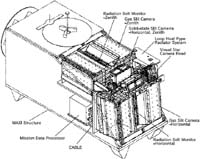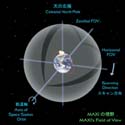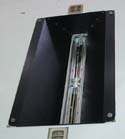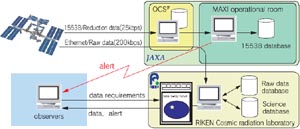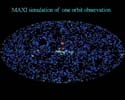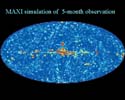This is an archive of information released in the past.
Disclaimer: It may contain broken links or outdated information. Some parts may not function in current web browsers.
*Visit https://humans-in-space.jaxa.jp/en/ for the latest information.

Experiment
- News
- Kibo Utilization Strategy
- Kibo Utilization Plan
- List of JAXA's Utilization Themes
- Experiment Facilities
- Space Environment Utilization
- Archive
All-sky X-ray scanner, consists of X-ray slit cameras with high sensitivity.
Continuously monitors astronomical X-ray objects over a broad energy band (0.5 to 30 keV).
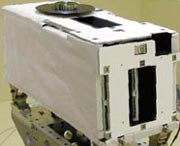 |
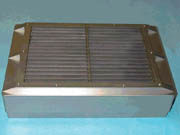 |
 |
 |
General Description
MAXI monitors the X-ray variability once every 96 minutes for more than 1,000 X-ray sources covering the entire sky on time scales from a day to a few months.
As an all-sky monitor, MAXI employs slit cameras.
They determine one direction of X-ray sources within the narrow field of view of the slit that is orthogonally oriented to a one-dimensional position-sensitive X-ray detector.
As an X-ray source moves according to the motion of the International Space Station, another position of the X-ray source is determined when the sources are captured by the collimated field of view of the camera.
The International Space Station orbits around the Earth every 96 minutes.
During this time, Maxi’s two semicircular (arc-shaped) fields of view will scan the whole sky once.
Slit Cameras
Two types of slit Cameras
MAXI employs two types of position-sensitive detectors, gas proportional counters and X-ray CCDs, aligned to two fields of views to observe both the zenith and horizontal directions.
Gas Slit Camera (GSC)
A slit camera with a gas proportional counter covers the 2 to 30 keV energy band with its large detection area.
·One-dimensional position-sensitive gas proportional counter with 10µm carbon anode wires, based on the method of charge division.
·MAXI is equipped with 12 counters with a total effective area of 5000 cm2.
Solid-state Slit Camera (SSC)
A slit camera with peltier-cooled X-ray sensitive CCD chips covers the 0.5 to 10 keV energy band with high resolution.
·The CCD chips are made in Japan.
·The pixel size is 24x24 µm, and there is a total of 1024x1024 pixels.
·MAXI is equipped with two cameras. One camera has 16 CCD chips, for a total effective area of 200 cm2.
Real-time(Online)data
Broadcasts the observed data immediately via internet, and transmits alerts on significant or transient phenomena such as X-ray novae.
The MAXI ground system at JAXA Tsukuba Space Center monitors MAXI down-linked data 15 to 17* hours/day while real-time connection with the ISS is established.
When a transient or significant phenomenon such as an X-ray nova is observed, the MAXI ground system will transmit alert information to observers of all over the world within 30sec after the incident.
Unbiased observed data for 4 to 5* hours/day will also be provided via internet from RIKEN.
* It depends on the operational status of ISS and data relay satellites during
MAXI observation.
#Operational Control System (OCS) :
JAXA's JEM operational control system
with a wide use data-base.
Contents of alert data (plan)
- New Objects (X-ray Novae, X-ray transient, gamma-ray burst, etc.)
Position ( accuracy <0.1°)
X-ray intensity, spectrum, and time variations.
- Known objects
In addition to the above information, object name and detailed information on the variation.
Alert method and limitation
·Internet Socket continuous connection
(Approved registration is required.)
·E-mail (Registration is required; users can
specify a threshold to be alerted for specific objects.)
·Web (Open to the public.)
Stored (Off-line) data
Observed data are post-processed for correction, and released as archival data.
All observed data, including non-real time data at loss of signal (LOS) will be released within a day as archival data after necessary post-processing such as data correction.
These data will be provided in the FITS format for analysis with FTOOLS and ASCII format for such as light curves.
Content of Archival data (plan)
(Release format I: image data such as jpeg, F: FITS, A: ASCII)
- Known objects
·light curves (I,F,A)
·power spectrum (I,F,A)
·energy spectrum (I,F) response files
·event files (F) - event files at specified position (F)
- All-sky map (I,F)
- Background data
- Analysis tools and calibration data
MAXI performance
| Gas Slit Camera (GSC) |
Sky Coverage | FOV = 160 degree(L) x 1.5 degree(FWHM), 2 directions 2 % of all-sky (instant) Scans 90 to 98 % of all-sky every 96 min (one orbit/rotation period of the ISS). |
| Imaging | Point Spread Function (PSF): 1.5 degrees (FWHM) Accuracy of position determination: < 6 arcmin |
|
| Spectroscopy | Detects X-ray photons of 2 to 30 keV . Resolution: 18 % at 5.9 keV |
|
| Timing Accuracy | 120 µsec with respect to GPS time | |
| Sensitivity (5σ) | 10 m Crab (1 orbit), 1 m Crab (1 week) | |
| Solid-state Slit Camera (SSC) |
Sky Coverage | FOV = 90 degrees (L) x 1.5 degrees (FWHM), 2 directions 1.3 % of all-sky (instant) Scans 70 % of all-sky every 96 min (one orbit/rotation period of the ISS). |
| Imaging | Point Spread Function (PSF): 1.5 degrees (FWHM) Accuracy of position determination: < 6 arcmin |
|
| Spectroscopy | Detects X-ray photons of 0.5 to 10 keV . Resolution: <150 eV at 5.9 keV |
|
| Timing Accuracy | 3 sec. to 16sec. (Depends on CCD read-out methods.) | |
| Sensitivity (5σ) | 20 m Crab (1 orbit), 2 m Crab (1 week) * | |
| Alert Delay | Real-time data | Real-time data will be down-linked to the ground instantly during over 50 % of the whole observation period. The delay time from an X-ray object crossing the FOV of cameras to transmitted alert after any analysis via internet is < 30 sec. |
| Data stored on board | Remaining data will be stored on board. The delay time from an X-ray object crossing the FOV of cameras to transmitted alert via internet is 20 min to 3 hours. | |
| User interface | Alert | Transmitting Alerts via Internet (socket, mail) on significant flux changes of X-ray sources. |
| Data utilization | General users can obtain images, energy spectrum, and light curves of any X-ray objects or sky area via internet (web browser). |
| Copyright 2007 Japan Aerospace Exploration Agency | Site Policy |
